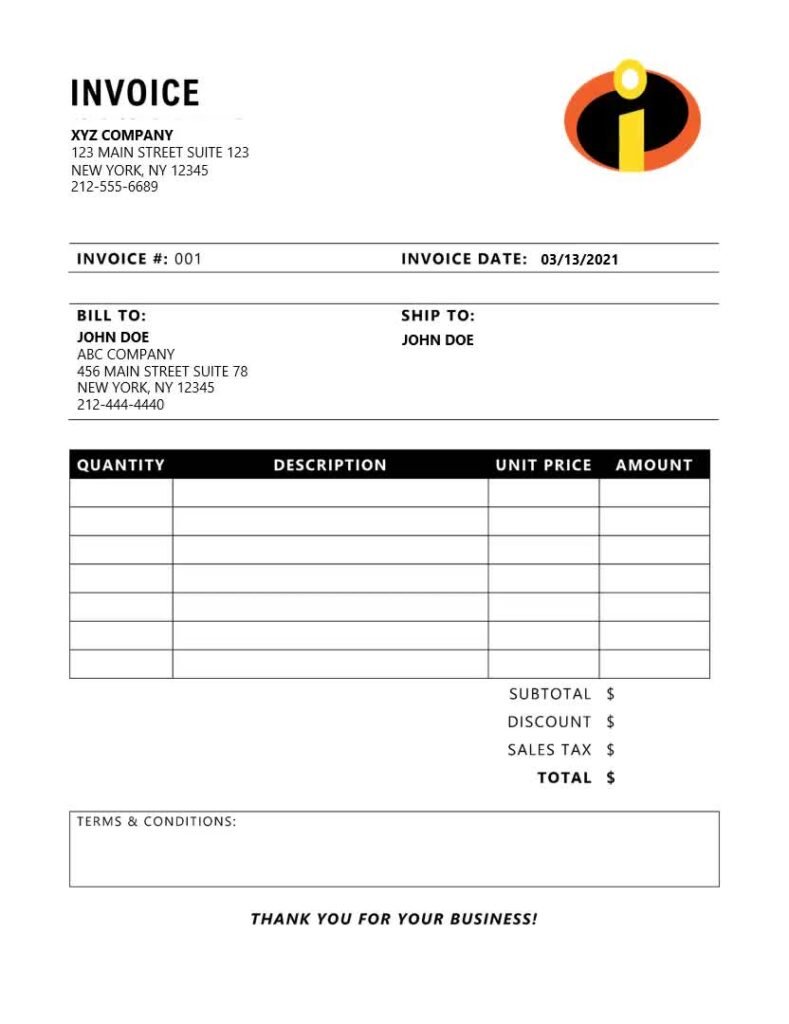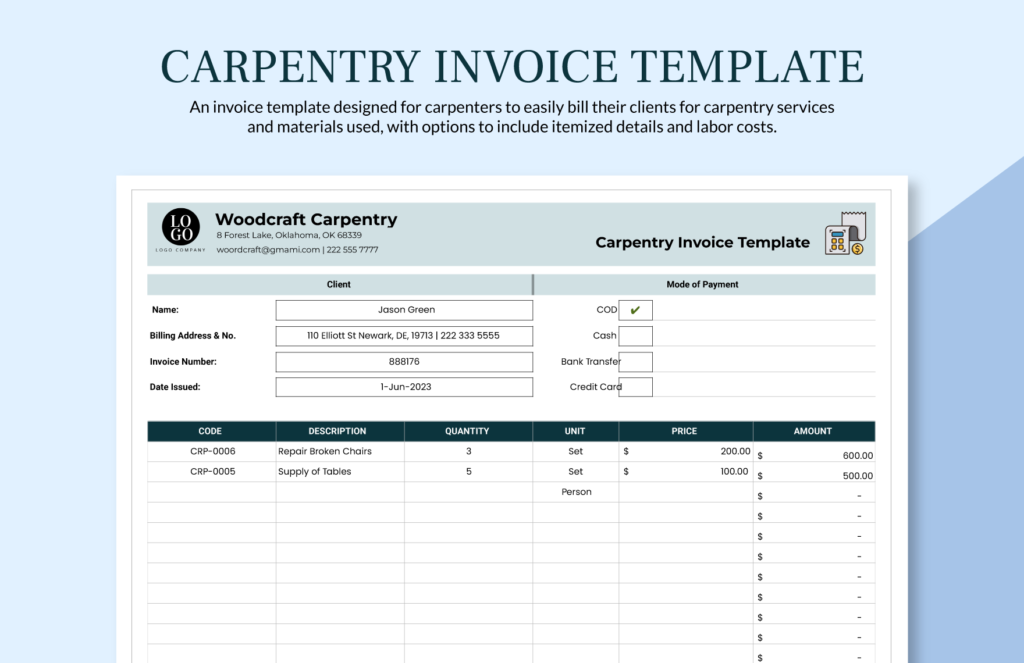Woodworking business essentials
As a woodworking business owner, it is essential to have a solid understanding of the key components that contribute to your success. One crucial aspect is creating a professional invoice for your clients. A woodworking invoice serves as a formal document that outlines the products or services you have provided, along with their associated costs. It not only acts as a record of the transaction but also helps maintain transparency and facilitates a smooth payment process. To simplify this task, you can utilize a woodworking invoice template available online. This template can be customized according to your specific needs, allowing you to include your business logo, contact information, and other essential details.

In addition to a woodworking invoice template, another important component to consider is billing terms and payment methods. Establishing clear and concise billing terms is crucial to avoid any confusion or disputes later on. This includes specifying the payment due date, any late payment fees, and acceptable forms of payment. By clearly communicating these terms to your clients, you can ensure a smooth and timely transaction process. Additionally, offering multiple payment methods, such as cash, check, or online payment platforms, can provide convenience for your clients and increase the likelihood of prompt payments.
Related:-Woodworking Edge Corner Plane
Creating a professional invoice
When it comes to running a woodworking business, creating professional invoices is essential. An invoice is much more than just a piece of paper; it serves as a legally binding document that outlines the terms of your agreement with the client. To create a professional invoice, start by including important details such as your business name, address, and contact information. This will not only give your invoice a polished and professional appearance but also help establish your credibility as a business owner. Additionally, make sure to include the client’s name, address, and contact information, along with the invoice number and date.
The key components of a woodworking invoice include a detailed description of the products and services provided. Be specific about the items or projects you worked on, the materials used, and the hours spent on each task. This level of detail will not only provide transparency to your clients but also help you track your expenses and profits. Moreover, include the quantity, rate, and total amount for each item or service provided, ensuring that the totals and calculations are accurate. By providing clear and concise information, your clients will have no confusion when it comes to understanding the charges and will be more likely to make prompt payments.
Key components of a woodworking invoice
When creating a woodworking invoice, there are several key components that you should include to ensure a professional and detailed document. The first component is the contact information of both the woodworking business and the client. This includes the business name, address, phone number, and email address, as well as the client’s name, address, and contact details. Including this information at the top of the invoice ensures that both parties can easily identify who the invoice is from and who it is for.
Another important component is the invoice number and date. Assigning a unique invoice number to each invoice helps with organization and tracking. It allows you to easily reference and locate specific invoices in the future. Alongside the invoice number, it is crucial to include the date of the invoice. This helps prevent any confusion or disputes about when the invoice was issued and when payment is due. Additionally, including a payment due date or terms can help set expectations and avoid late payment issues.
Understanding billing terms and payment methods
When running a woodworking business, it is crucial to have a clear understanding of billing terms and payment methods. This ensures that you are able to effectively communicate with your clients and receive timely payments for your products and services. One key aspect to consider is the payment terms you offer, such as whether you require full payment upfront, a percentage as a deposit, or if you offer payment plans. It is important to establish these terms with your clients before starting any work to avoid any misunderstandings or disputes later on.
Another important factor is the payment methods you accept. While cash and check payments may still be common in some woodworking businesses, it is wise to consider offering alternative payment options, such as credit card payments or online payment platforms. This not only makes it more convenient for your clients, but it also reduces the likelihood of late payments, as many electronic payment methods provide immediate confirmation of the transaction. Be sure to clearly communicate the payment methods you accept to your clients and provide them with all the necessary payment details to ensure a smooth and efficient payment process.
Tips for accurately pricing your woodworking projects
Setting the right price for your woodworking projects can sometimes be tricky, but with a few key tips, you can ensure that you accurately price your work. Firstly, consider the cost of materials. Take into account the price of the wood, as well as any other materials such as hardware or finishing products. Additionally, factor in the time and labor required to complete the project. Estimate how long it will take you to construct the piece, and consider how much you typically charge per hour. A fair and reasonable price should cover both your materials and your time.

Another important aspect to consider when pricing your woodworking projects is your competition. Research other woodworkers in your area or those who offer similar products online. Take note of their pricing strategies and see how your products compare in terms of quality and craftsmanship. Keep in mind that it is not always necessary to match the exact prices of your competitors, as you may offer unique features or a higher level of expertise. However, having an understanding of what others charge will help you position your prices competitively. Ultimately, finding the right balance between covering your costs and remaining competitive in the market is key to accurately pricing your woodworking projects.
Including detailed descriptions of products and services
To effectively communicate the value of your woodworking products and services, it is imperative to include detailed descriptions. A comprehensive description helps potential customers understand the features, functionality, and unique characteristics of your offerings. By using descriptive language and highlighting key selling points, you can create a compelling narrative that showcases the craftsmanship and quality inherent in your work.
For example, when describing a handcrafted dining table, you might mention the type of wood used, such as sustainably sourced oak, highlighting its durability and natural beauty. Additionally, you could mention the unique design elements, such as intricate woodwork or a hand-carved pattern, that make the table truly one-of-a-kind. Describing the table’s dimensions, seating capacity, and any special features, such as built-in extensions or custom finishes, further enhances the customer’s understanding and appreciation for your product. By providing a comprehensive description, potential customers can envision how the table will fit into their own space and meet their specific needs.
Why is including detailed descriptions of products and services important for a woodworking business?
Including detailed descriptions of products and services is important for a woodworking business because it helps customers understand exactly what they are purchasing. It allows them to make informed decisions and helps build trust in your brand.
What are some key components that should be included in a woodworking invoice?
Some key components that should be included in a woodworking invoice are the customer’s name and contact information, a description of the products or services provided, quantities, prices, any applicable taxes or fees, and the total amount due.
How can I create a professional invoice for my woodworking business?
To create a professional invoice for your woodworking business, you can use invoice templates available online or use accounting software that offers invoicing features. Make sure to include all the necessary information and present it in a clear and organized manner.
What are billing terms and why should I include them in my woodworking invoices?
Billing terms refer to the agreed-upon terms between the business and the customer regarding payment. It includes details such as due dates, late fees, and accepted payment methods. Including billing terms in your woodworking invoices helps set clear expectations and avoids any confusion or disputes.
How can I accurately price my woodworking projects?
Accurately pricing your woodworking projects requires careful consideration of factors such as material costs, labor time, overhead expenses, and desired profit margin. It is important to analyze these components and calculate a fair price that covers all expenses while remaining competitive in the market.

Why should I include detailed descriptions of products and services in my woodworking invoices?
Including detailed descriptions of products and services in your woodworking invoices helps avoid misunderstandings and disputes. It provides transparency to your customers regarding what they are paying for and ensures they are satisfied with the final product or service received.




